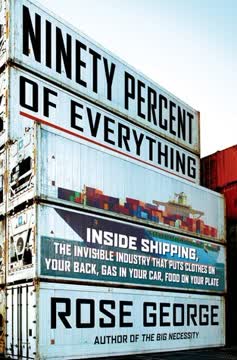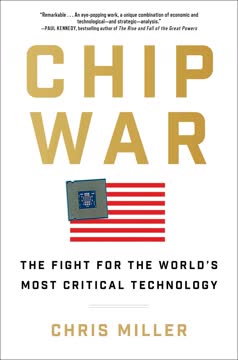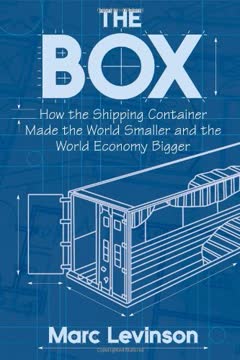Key Takeaways
1. The Container: A Disruptive Force
The container made shipping cheap, and by doing so changed the shape of the world economy.
Global transformation. The humble shipping container, a "soulless aluminum or steel box," fundamentally reshaped global commerce. Before its widespread adoption, transporting goods was prohibitively expensive, limiting international trade and fostering localized production. The container's true value lies not in its physical form, but in its role as the core of a highly automated system that drastically cut freight costs and complications.
Economic ripple effects. This cost reduction had profound, often unforeseen, consequences. It dismantled old economic structures, such as:
- Armies of dockworkers and their tight-knit waterfront communities.
- Centuries-old maritime cities like New York and Liverpool, whose traditional waterfronts became obsolete.
- Venerable shipping lines unable to adapt to the new capital-intensive model.
Conversely, it built a new global economy, enabling: - The rise of new port powerhouses like Busan, Seattle, Felixstowe, and Tanjung Pelepas.
- Factories to relocate to areas with cheaper land and labor, freed from the necessity of port proximity.
- The proliferation of sprawling industrial complexes in places like Los Angeles and Hong Kong.
Globalization's engine. The container allowed purely domestic firms to become international exporters, competing effortlessly across borders. It eliminated the "shelter" of high transport costs for local producers, forcing global competition. This shift led to an explosion in product variety for consumers and held down prices, boosting living standards worldwide, though it also increased capital mobility, impacting workers' bargaining power.
2. Pre-Container Gridlock: A Bottleneck in Trade
By far the biggest expense in this process was shifting the cargo from land transport to ship at the port of departure and moving it back to truck or train at the other end of the ocean voyage.
Inefficient breakbulk system. In the early 1950s, freight transportation was a laborious, manual process. Goods arrived at ports piece by piece, were unloaded, tallied, stored in transit sheds, then re-loaded onto ships, often by hand. This "breakbulk" method was slow, expensive, and prone to damage and theft. Ships spent more time docked than at sea, incurring significant costs.
Labor-intensive operations. Dockworkers, or longshoremen, performed brutally physical and often dangerous work. Their employment was highly irregular, leading to:
- The "shape-up" system, where workers competed daily for jobs, fostering corruption and kickbacks.
- A distinct, insular waterfront culture marked by strong solidarity, but also resistance to change.
- High rates of theft and frequent labor disputes, as unions fought to protect jobs and improve conditions.
These factors made cargo handling the single largest expense in ocean shipping, often accounting for half or more of a voyage's total cost.
Early container failures. The concept of large shipping boxes existed for decades, with railways and some coastal shipping lines experimenting with them. However, these early attempts largely failed to reduce costs significantly. Containers were often:
- Too small or incompatible across different carriers.
- Made of heavy, costly materials.
- Difficult to handle, requiring manual labor or damaging forklifts.
- Subject to customs duties on the box itself and expensive empty returns.
Without a standardized, integrated system, containers offered little advantage over traditional breakbulk methods, leaving ports in a state of "gridlock."
3. Malcom McLean's Vision: The Trucker Who Revolutionized Shipping
McLean understood that transport companies’ true business was moving freight rather than operating ships or trains.
An outsider's insight. Malcom McLean, a self-made trucking magnate from North Carolina, was not a shipping industry insider. His obsession with cutting costs in his trucking business led him to question the inefficiencies of traditional freight transport. Faced with highway congestion and competitive pressures, he conceived the radical idea of putting entire truck trailers on ships to bypass roads.
From "piggyback" to "box." McLean's initial plan involved "roll on–roll off" ships carrying full truck trailers. However, he soon realized the inefficiency of transporting wheels and chassis by sea. His pivotal insight was to detach the truck bodies (containers) from their undercarriages, allowing them to be stacked and saving precious shipboard space. This led to the conversion of the tanker Ideal-X in 1956, marking the birth of modern container shipping.
Total system approach. McLean's genius lay in understanding that the revolution required more than just a metal box; it demanded a complete overhaul of the freight handling system. He commissioned:
- Specialized, stackable containers (35-foot aluminum boxes).
- New lifting equipment, like the spreader bar and twist locks, for rapid loading/unloading.
- Purpose-built terminals with large cranes and marshaling yards.
- An integrated "sea-land" service, contracting with truckers to handle inland transport.
This holistic vision, focused on door-to-door freight movement, was years ahead of the industry and set the stage for the container's transformative impact.
4. Engineering the System: Innovation Beyond the Box
The combination of cells and gantry cranes allowed the containers to be handled with unprecedented speed.
Designing for efficiency. The success of McLean's vision depended on meticulous engineering. Keith Tantlinger, McLean's chief engineer, was instrumental in developing the critical components of the container system. His innovations included:
- Cellular holds: Metal frames (spardecks) and later, honeycomb-like cells within ship holds to precisely fit and stack containers, maximizing space and stability.
- Twist locks: A simple yet revolutionary steel casting and locking device that allowed containers to be quickly secured to chassis, stacked, and locked together, enabling rapid transfer and preventing shifting at sea.
- Gantry cranes: Massive, shore-based or shipboard cranes with spreader bars that could lift and position containers with precision and speed, drastically cutting loading times.
Matson's methodical approach. While McLean was aggressive, Matson Navigation Company, a major West Coast carrier, took a more cautious, data-driven approach. Led by geophysicist Foster Weldon and naval architect Leslie Harlander, Matson conducted extensive research and simulations to determine optimal container sizes (24-foot) and terminal designs. Their meticulous testing ensured structural integrity and operational efficiency, even if their initial container size differed from McLean's.
Unprecedented speed and scale. These engineering breakthroughs enabled a dramatic increase in port productivity. The Gateway City, one of Pan-Atlantic's first converted containerships, could be emptied and reloaded in just eight hours, a fraction of the time required for conventional vessels. This efficiency, combined with the ability to handle hundreds of containers per ship, laid the foundation for the massive scale of future container operations.
5. Union Resistance and Adaptation: A Battle for Jobs
Those guys who think we can go on holding back mechanization are still back in the thirties, fighting the fight we won way back then.
Automation's threat. The container posed an existential threat to longshoremen's jobs, as it drastically reduced the need for manual cargo handling. Both the International Longshoremen's Association (ILA) on the East Coast and the International Longshoremen's and Warehousemen's Union (ILWU) on the West Coast recognized this. Their responses, however, diverged significantly.
ILWU's strategic compromise. Under the leadership of Harry Bridges, the ILWU, after intense internal debate and initial resistance, adopted a pragmatic approach. The 1960 "Mechanization and Modernization Agreement" (M&M) allowed employers "unlimited freedom to automate" in exchange for:
- A share of the cost savings (a $5 million annual payment from employers).
- Guaranteed annual income for existing "A-men" (senior longshoremen).
- Early retirement incentives.
This agreement, though controversial, allowed West Coast ports to embrace containerization with fewer labor disruptions, leading to massive productivity gains, often through harder physical work rather than immediate automation.
ILA's protracted struggle. The ILA, led by Teddy Gleason, initially resisted automation more fiercely, demanding "spread the fruits of automation" through make-work rules like "stripping and stuffing" all containers at the pier. Internal divisions and frequent strikes plagued negotiations. Eventually, the 1964 contract for New York and Philadelphia introduced:
- Smaller gang sizes.
- A "Guaranteed Annual Income" (GAI) for qualified longshoremen, funded by a container royalty.
- This provided a permanent subsidy for displaced dockers, but job losses in New York City were still catastrophic, falling 91% in twelve years.
Mixed blessings. While both unions secured unprecedented benefits for their members, containerization irrevocably changed dock work. Traditional skills lost value, and the casual, independent nature of the job gave way to a more structured, factory-like environment. Despite the discontents, these agreements set a precedent for compensating workers affected by technological displacement, a principle rarely adopted elsewhere in the American economy.
6. Ports: Adapt or Decline in the Container Age
For ports, capturing container traffic was going to be expensive, requiring investments out of all proportion to what had come before.
The new maritime geography. Containerization fundamentally altered the competitive landscape for ports. The economics dictated that maritime traffic would consolidate around a few very large "load centers" capable of handling massive containerships quickly. This meant:
- Traditional, often cramped, urban ports became obsolete.
- Ports needed vast tracts of land for container storage and efficient road/rail connections.
- The required investments in dredging, wharves, and cranes were enormous, far beyond the capacity of private shipping lines.
West Coast's "arms race." Pacific ports, initially backwaters, saw containerization as a chance to escape geographic constraints. Cities like Oakland, Seattle, Los Angeles, and Long Beach engaged in a fierce competition, investing hundreds of millions in new container terminals, often without guaranteed tenants. Oakland, in particular, aggressively pursued container business, even building terminals speculatively.
East Coast's mixed response. On the Atlantic, only the Port of New York Authority's complex in Newark and Elizabeth fully embraced containerization early on, becoming the dominant East Coast container hub. Other traditional ports, like Boston and Philadelphia, were slower to adapt due to labor issues and funding challenges, leading to a decline in their maritime importance.
Global transformation. The pattern repeated worldwide. Rotterdam, Antwerp, and Bremen in Europe, and later Yokohama, Kobe, Sydney, and Singapore in Asia, made massive investments to become major containerports. Conversely, once-dominant ports like London and Liverpool saw their traditional docks wither, replaced by new, purpose-built facilities in less congested, deeper-water locations like Felixstowe. This era marked a decisive shift in port development from local, incremental growth to large-scale, publicly-funded strategic investments.
7. Vietnam War: The Container's Proving Ground
Containerization enabled the United States to sustain a well-fed and well-equipped force through years of combat in places that would otherwise have been beyond the reach of U.S. military might.
Logistical nightmare. The rapid U.S. military buildup in Vietnam in 1965 exposed a catastrophic logistical mess. Traditional breakbulk shipping led to:
- Hopelessly tangled supply chains and severe port congestion in shallow Vietnamese harbors.
- Ships serving as "floating warehouses" due to lack of onshore storage.
- Massive cargo theft and inefficiency, with supplies often arriving late, unexpected, or unneeded.
The military's "push" supply system, sending supplies based on assumptions rather than requests, exacerbated the chaos.
McLean's intervention. Malcom McLean, seeing the crisis, convinced General Frank Besson, head of army supply, that containerization was the solution. Despite initial military skepticism and lack of infrastructure, Sea-Land secured contracts to provide container service. This involved:
- Converting a DeLong pier at Cam Ranh Bay into a containerport.
- Assembling cranes and other equipment in a war zone.
- Providing integrated door-to-door service, including trucks and chassis.
- Implementing a sophisticated computer system to track containers.
Unparalleled efficiency. The results were dramatic. Sea-Land's containerships, like the Oakland, delivered hundreds of containers every two weeks, moving as much cargo as twenty conventional vessels. Port congestion dissipated, and supply backlogs cleared. The military, initially hesitant, became containerization's greatest advocate, adopting commercial-size containers and revamping its logistics around the "Three Cs": one container, one customer, one commodity. This wartime validation proved the container's immense value and accelerated its global commercial adoption.
8. Boom, Bust, and Relentless Scale: The Industry's Volatile Growth
The costliest merchant ships ever built were also the thirstiest, each burning five hundred tons of fuel per day.
The "arms race" begins. By 1969, container shipping had transformed from an infant industry into a rip-roaring, yet extremely expensive, business. The success of early pioneers like Sea-Land spurred a global "arms race" in containership construction. The second generation of containerships, like the American Lancer, were purpose-built, larger (1,200+ TEUs), and faster (23+ knots), costing tens of millions each.
Conglomerates and overcapacity. Traditional shipping lines, unable to finance these massive investments, formed consortia or were acquired by cash-rich conglomerates like R.J. Reynolds (which bought Sea-Land). This influx of capital led to a surge in capacity, with hundreds of new containerships entering service by the mid-1970s. Demand, robust as it was, could not keep pace, leading to:
- Rate wars: Unlike breakbulk shipping, containerships had high fixed costs (mortgages, terminal leases) that had to be paid regardless of cargo volume, forcing lines to cut rates to fill ships.
- Conference collapse: The traditional cartel system of liner conferences struggled to maintain artificially high rates in the face of fierce competition.
Oil shocks and McLean's gamble. The 1973 oil crisis exacerbated the industry's woes, as fuel costs quadrupled, disproportionately impacting the new, fuel-guzzling containerships. McLean, now with R.J. Reynolds, gambled on the ultra-fast SL-7s, which became a crushing burden due to their high fuel consumption. His subsequent venture with U.S. Lines and the slow, massive "Econships" also failed spectacularly when oil prices plummeted, leading to the largest bankruptcy in U.S. history at the time. These cycles of boom and bust became a permanent feature of the capital-intensive container industry.
9. Shippers' Ascendancy: Deregulation and Plummeting Costs
The rates actually charged vary widely and often deviate substantially from published tariffs.
Initial limited benefits. In the early years of international container shipping (up to the mid-1970s), shippers saw only modest benefits. While ship lines' costs fell, conferences often kept container rates high, tied to breakbulk pricing. Land transport remained fragmented and expensive, with regulations preventing seamless intermodal pricing.
Shippers gain power. The late 1970s marked a turning point as shippers, initially passive, became more sophisticated and organized. They began to:
- Challenge conferences: Forming shippers' councils and actively seeking out non-conference carriers like Maersk and Evergreen, who offered significant discounts.
- Demand transparency: The shift to flat per-container rates, rather than complex commodity-based tariffs, exposed the true cost reductions.
- Leverage overcapacity: The persistent oversupply of container shipping capacity gave shippers immense bargaining power, driving down rates.
Deregulation's catalyst. Crucially, the deregulation of U.S. domestic transportation in the early 1980s (trucking and rail) removed major barriers to efficiency. Railroads could now:
- Negotiate long-term contracts with shippers, offering volume discounts.
- Invest in "double-stack" trains, carrying two containers per railcar, drastically cutting land transport costs.
- Integrate international and domestic freight, reducing empty container returns.
The Shipping Act of 1984 further empowered shippers by allowing direct service contracts with ship lines, bypassing conferences. This confluence of factors led to a dramatic, sustained fall in door-to-door international freight costs, making global trade far more accessible.
10. The "Just-in-Time" Revolution: Global Supply Chains Emerge
Any change in technology leads almost inevitably to an improvement in the welfare of some and to a deterioration in that of others.
Disintegrated production. The plummeting, reliable, and predictable transport costs enabled by containerization, combined with advances in communication and computing, fundamentally reshaped manufacturing. The traditional model of vertically integrated production gave way to "disintegrated production" and complex global supply chains. Companies could now:
- Contract with specialized suppliers worldwide for raw materials and components.
- Manufacture each component or product stage in the most economical location, considering wages, taxes, and energy costs.
- Ship intermediate goods across continents for further processing.
Just-in-Time (JIT) logistics. The container was indispensable for the adoption of "just-in-time" manufacturing, pioneered by Toyota. JIT relies on minimal inventories, requiring components and products to arrive precisely when needed. This precision, unimaginable before containers, led to:
- Massive reductions in inventory costs for manufacturers and retailers (saving hundreds of billions annually in the U.S. alone).
- Increased discipline throughout the supply chain, as there was little margin for error.
- A shift in focus from holding large stocks to optimizing the flow of goods.
Reshaping economic geography. The container lowered the "trade barrier" of high transport costs, making it economically viable to source and sell globally. This led to:
- The decimation of manufacturing employment in high-wage countries.
- The rise of the Pacific Rim as the world's workshop for consumer goods.
- The emergence of "logistics clusters" and "freight villages" far from traditional ports, where goods are processed and distributed.
However, this also created new geographical disadvantages for landlocked countries or those with inefficient ports, highlighting the uneven distribution of globalization's benefits.
11. Ports Evolve: From Hubs to Value-Added Centers
It’s not a game about tons, it’s a game about employment and diversification, and added value creation.
Beyond throughput. As container volumes soared, ports faced new challenges and opportunities. The relentless pursuit of scale by ship lines meant fewer, larger ships calling at fewer, larger ports. This led to:
- Increased competition among ports to attract mega-ships, often requiring billions in public and private investment for deeper harbors and massive terminals.
- A shift from public to private port management, as governments became wary of the financial risks.
- The realization that simply handling more containers (TEUs) was no longer enough to justify the environmental and social costs (noise, pollution, congestion).
Adding value onshore. Ports began to redefine their role, moving beyond mere cargo transfer to become "logistics clusters" and "value-added centers." This involves:
- Attracting businesses that perform manufacturing or processing activities near the docks.
- Developing sophisticated distribution centers that can customize products (e.g., labeling, packaging) before final delivery.
- Promoting intermodal connections (rail, barge) to extend their reach inland.
Examples like Antwerp and Dubai illustrate this transformation, leveraging their port infrastructure to become regional trade and financial hubs, creating jobs and economic output beyond simple cargo handling.
The future of the box. The container revolution continues to evolve. Mega-ships push the limits of port infrastructure and efficiency, leading to new challenges like longer port calls and the need for offshore terminals. Automation on the docks, from remote-controlled cranes to unmanned vehicles, further reduces labor needs, transforming dock work into a highly skilled, technology-driven profession. The container, once a simple box, remains a dynamic force, constantly reshaping global trade and the economies it touches.
Last updated:
Review Summary
The Box receives mostly positive reviews for its fascinating exploration of how shipping containers revolutionized global trade. Readers appreciate the detailed history, economic analysis, and insights into labor relations and port cities. Some find parts dry or overly technical, but many praise its engaging storytelling and broader implications. Critics note a lack of visuals and data. Overall, reviewers recommend it for those interested in logistics, globalization, and 20th-century economic history, highlighting its surprising depth on an seemingly mundane topic.
Similar Books









Download EPUB
.epub digital book format is ideal for reading ebooks on phones, tablets, and e-readers.





